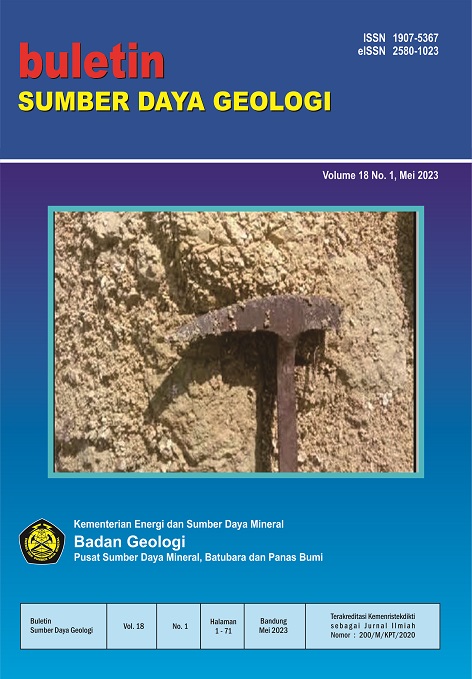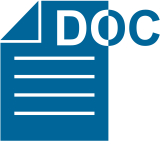KARAKTERISTIK MINERALISASI CEBAKAN AU±LOGAM DASAR DI TAMILOUW – HAYA, PULAU SERAM, MALUKU
MINERALIZATION CHARACTERISTIC OF AU±BASE METAL DEPOSIT AT TAMILOUW - HAYA, SERAM ISLAND, MALUKU
Abstract
The research area is located in the southern part of Seram Island, Maluku, which is at an elevation of 3 to 675 meters above sea level; is composed of metapelites to low-grade metamorphic rocks, coralline limestone and alluvial deposits. The purpose of this investigation is to study geological control, mineralization characteristics and ore geochemistry of Au±basemetal deposit in Tamilouw – Haya. Investigation activities began with literature review, field investigations for sampling, geological mapping, alteration & mineralization and laboratory analysis which including polish sections and ore geochemistry (FA/AAS). Based on the results of investigation, it shows that mineralization in Tamilouw - Haya is associated with 3 type of veins, namely quartz veins (V1) that parallel to the foliation plane (concordant), quartz veins that cutting through foliation plane (V2) and third generation veins (V3) are quartz ±carbonate veins associated with breccia - stockwork and formed at the end of veins formation. Massive texture is found in most of the veins, especially those with relatively large dimensions. Vein filling minerals are dominated by quartz, sulfide minerals and precious metals while dominant sulfide veins consist of pyrite and arsenopyrite. Metal sulfide mineralizations at Tamilouw – Haya are pyrite, gold, chalcopyrite, sphalerite, galena, pyrhotite, tetrahydrite, tenantite, marcasite, arsenopyrite, sinabar, kalininite and realgar. Gold grades reaching 0.006 to 7.45 ppm.
Downloads
References
Barton, P.B.Jr., 1978. Some ore textures involving sphalerite from the Furutobe Mine, Akita Prefecture, Japan. Mining Geology, 28, 293-300.
Barton, P.B.Jr., Bethke, P.M., 1987. Chalcopyrite disease in sphalerite: Pathology and epidemiology. American Mineralogist, 72 (5-6), 451-467.
Franklin, Moe’tamar, Reza, M., 2013. Inventarisasi endapan logam di Kabupaten Seram Bagian Barat Provinsi Maluku. Laporan internal. Tidak dipublikasikan. Pusat Sumber Daya Geologi, Bandung.
Gebre-Mariam, M., Hagemann, S.G., Groves, D.I., 1995. A classification scheme for epigenetic Archaean lode-gold deposits. Miner Deposita, 30, 408-410
Goldfarb, R.J.,Groves D.I.,Craig Har., 2005. Distribution, character and genesis of gold deposits in metamorphic terranes. Economic Geology, 407-450
Groves, D.I.,1993. The crustal continuum model for late-Archean lode gold deposits of the Yilgarn block, Western Australia. Mineral Deposits, 28, 366-374
Hakim, A.Y.A., Melcher, F., Prochaska, W., Bakker, R., Rantitsch, G., 2018. Formation of epizonal gold mineralization within the Latimojong Metamorphic Complex, Sulawesi, Indonesia : Evidence from mineralogy, fluid inclusions and Raman spectroscopy. Ore Geology Reviews, 97, 88-108.
Hasria., 2018. Karakteristik mineralisasi emas hidrotermal yang berasosiasi dengan batuan metamorf di Pegunungan Mendoke dan Rumbia pada lengan tenggara Pulau Sulawesi, Indonesia. Disertasi. Universitas Gadjah Mada, Yogyakarta.
Idrus, A., Nur, I., Warmada, I.W., Fadlin., 2011. Metamorphic Rock-Hosted Orogenic Gold Deposit Type as a Source of Langkowala Placer Gold, Bombana, Southeast Sulawesi. Indonesian Journal on Geoscience, 6, 43-49
Idrus, A., Prihatmoko, S., Hartono, G.H., Ernowo, Franklin, Moetamar, Setiawan, I., 2014. Some Key Features and Possible Origin of the Metamorphic Rock-Hosted Gold Mineralization in Buru Island, Indonesia. Indonesian Journal on Geoscience, 1, 9-19
Patria, A., Hall, R. 2018. Oblique Intraplate Convergence of the Seram Trough, Indonesia. Bulletin of the Marine Geology, 33, 41 – 58
Pownall, J.M., Hall, R. and Watkinson, I.M. 2013. Extreme extension across Seram and Ambon, eastern Indonesia : evidence for Banda slab rollback. Solid Earth, 4: 277–314.
Pownall, J.M., Forster, M.A., Hall, R., Watkinson I.M., 2017. Tectonometamorphic evolution of Seram and Ambon, eastern Indonesia: Insights from 40Ar/39Ar geochronology. Gondwana research, 44, 35-53
Querubin, C.D., Walter, S., 2012. Geology and Mineralization of Awak Mas: A Sedimentary Hosted Gold Deposit, South Sulawesi, Indonesia. Majalah Geologi Indonesia, 27, 69-85
Samalehu, H., 2021. Geologi, karakteristik dan mineralisasi hidrotermal batuan metamorf kompleks Tehoru dan Taunusa di Pulau Seram, Indonesia. Disertasi. Universitas Gadjah Mada, Yogyakarta.
Tjokrosapoetro, S., Achdan, A., Suwitodirdjo, S., Rusmana, E.,Abidin, H.Z., 1993. Pemetaan Geologi lembar Masohi sekala 1 : 250.000. Pusat Penyelidikan dan Pengembangan Geologi, Bandung.
Tjokrosapoetro, S., Budhitrisna, T., 1982. Geology and tectonics of the northern Banda Arc. Bulletin of the Indonesian Geological Research and Development Centre, 6, 1–17.
Wadji, M.F., Santoso, S.T.J., Kusumanto, D., Digdowirogo, S., 2011. Metamorphic Hosted Low Sulfidation Epithermal Gold System at Poboya, Central Sulawesi : A General Descriptive Review, Proceedings of The Sulawesi Mineral Seminar, Manado 28-29 November 2011, 201-210.
Copyright (c) 2023 Buletin Sumber Daya Geologi

This work is licensed under a Creative Commons Attribution-NonCommercial-ShareAlike 4.0 International License.
Authors whose manuscripts are published agree to the following terms:
The publication rights of all journal manuscript materials published on the Buletin Sumber Daya Geologi website are held by the editorial board with the knowledge of the author (moral rights remain with the manuscript’s author).
The formal legal provisions for access to digital articles in this electronic journal are subject to the terms of the Creative Commons Attribution-ShareAlike (CC BY-SA) license. This means that Buletin Sumber Daya Geologi has the right to store, convert media/formats, manage in the form of a database, maintain, and publish the article without requesting permission from the author, as long as the author’s name is cited as the copyright holder.
Manuscripts published in both print and electronic formats are open access for educational, research, investigative, and library purposes. Beyond these purposes, the editorial board is not responsible for any violations of copyright law.















